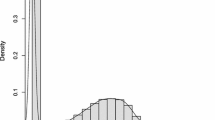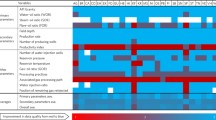Abstract
A quantitative analytical method, using a spreadsheet, has been developed that allows the determination of values of the three parameters that characterize the Hubbert-style Gaussian error curve that best fits the conventional oil production data both for the U.S. and the world. The three parameters are the total area under the Gaussian, which represents the estimated ultimate (oil) recovery (EUR), the date of the maximum of the curve, and the half-width of the curve. The “best fit” is determined by adjusting the values of the three parameters to minimize the root mean square deviation (RMSD) between the data and the Gaussian. The sensitivity of the fit to changes in values of the parameters is indicated by an exploration of the rate at which the RMSD increases as values of the three parameters are varied from the values that give the best fit. The results of the analysis are as follows: (1) the size of the U.S. EUR of oil is suggested to be 0.222 × 1012 barrels (0.222 trillion bbl) of which approximately three-fourths appears to have been produced through 1995; (2) if the world EUR is 2.0 × 1012 bbl (2.0 trillion bbl), a little less than half of this oil has been produced through 1995, and the maximum of world oil production is indicated to be in 2004; (3) each increase of one billion barrels in the size of the world EUR beyond the value of 2.0 × 1012 bbl can be expected to result in a delay of approximately 5.5 days in the date of maximum production; (4) alternate production scenarios are presented for world EURs of 3.0 and 4.0 × 1012 bbl.
Similar content being viewed by others
REFERENCES
Adelman, M. A., and Lynch, M. C., 1997, Fixed view of resource limit creates undue pessimism: Oil & Gas Journal, v. 95, no. 14, p. 56–60.
Bartlett, A. A., 1978, Forgotten fundamentals of the energy crisis: Am. Jour. of Phys., v. 46, p. 876–888.
Bartlett, A. A., 1997-98, Reflections on sustainability, population growth, and the environment— revisited: Renewable Resources Jour., v. 15, no. 4, Winter 1997–1998, p. 6–23.
Campbell, C. J., and Laherrere, J. H., 1998, The end of cheap oil: Scientific American, v. 278, no. 3, p. 78–83.
Edwards, J. D., 1997, Crude oil and alternate energy production forecasts for the twenty-first century: The end of the hydrocarbon era: Am. Assoc. Petroleum Geologists, Bull., v. 81, no. 8, p. 1292–1305. [Much of this work was available earlier in a report from the Energy and Minerals Applied Research Center (EMARC) (1996), Department of Geological Sciences, University of Colorado at Boulder, Boulder, CO 80309-0250.]
Hubbert, M. K., 1974, U.S. energy resources, a review as of 1972; A background paper prepared at the request of Henry M. Jackson, Chairman, Committee on Interior and Insular Affairs, United States Senate, Pursuant to Senate Resolution 45, A National Fuels and Energy Policy Study: Serial No. 93-40 (92-75), Part 1. U.S. Government Printing Office, Washington, 1974, p. 186.
Hubbert, M. K., 1982, Oil and gas supply modeling: NBS special publication 631, U.S. Department of Commerce/National Bureau of Standards (now the National Institute of Standards andTechnology, NIST) May 1982, p. 90.
Ivanhoe, L. F., 1995, Future world oil supplies: There is a finite limit: World Oil, v. 216, no. 10, p. 77–88.
Ivanhoe, L. F., 1997, King Hubbert—updated: Hubbert Center Newsletter, No. 97/1 Colorado School of Mines, Golden, CO.
MacKenzie, J. J., 1996, Oil as a finite resource: When is global production likely to peak? World Resources Institute, 1709 New York Ave., NW, Washington, DC, 20006.
Masters, C. D., Root, D. H., and Attanasi, E. D., 1994, World petroleum assessment and analysis: Proceedings of the 14th World Petroleum Congress: John Wiley & Sons, New York, p. 529–541.
U.S. Energy Information Administration, 1995, Annual Energy Review, DOE/EIA(95). (The U.S. production data are from the column “Crude Oil” of Table 5.1, p. 141; The world production data are from the column “ World” of Table 11.5, p. 297.)
Author information
Authors and Affiliations
Rights and permissions
About this article
Cite this article
Bartlett, A.A. An Analysis of U.S. and World Oil Production Patterns Using Hubbert-Style Curves. Mathematical Geology 32, 1–17 (2000). https://doi.org/10.1023/A:1007587132700
Issue Date:
DOI: https://doi.org/10.1023/A:1007587132700




